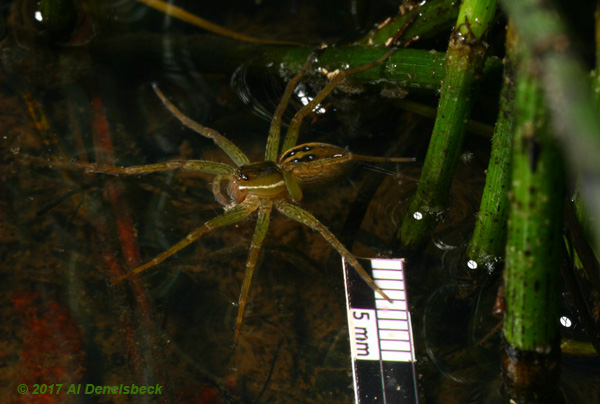Canon 30D, handheld
Reversed Sigma 28-105 at 28mm, f16
36mm extension tube
Sunpak Auto 322 flash with custom softbox
1/200 second at ISO 250
Canon 30D, handheld |
| Seeing eye to eyes | |
 |
|
I really shouldn't do this. I'm well aware that any photos of spiders can chase people off, but extreme closeups of their faces is exponentially worse. But then again, I'm very pleased with the detail, and if I don't show my stuff here, where am I going to show it off?
In the backyard is a small pond liner with a couple different kinds of water plants, which immediately attracted several species of frogs. And just a little later on, at least two species of fishing spiders. Fishing spiders are interesting specimens,not only able to skate across the surface of the water to capture bugs that have fallen in, but also able to dive beneath the surface and scamper around underwater, breathing the air that adheres to their bodies.
One summer I found a juvenile six-spotted fishing spider (Dolomedes triton) hanging out at the base of the scouring rushes, working on a recent capture. I did several images of it where it sat, but a little later on, after I supposed it had finished its meal, decided that I wanted to see just how detailed I could get. The exercise in getting the spider to enter a cup went much better than expected, as did switching it over to a macro aquarium. Filled to the edge of the glass, I could shoot directly level with the water surface and thus at eyes-level with the arachnid. And the whole time, the spider behaved very placidly, even allowing me to rotate it more to face me, which was done by dragging a twig in the water near it, which stirred up eddies that caused the floating spider to drift around in a semi-circle. The result you see here.
Two things can be noted from this intense portrait. The first is, the spider wasn't completely done with her meal after all – there are two grey legs of her prey able to be seen clearly. And yes, this is a female, while can be determined by the shape of the pedipalps, those hairy 'legs' curving down on either side of her meal – males have club-shaped tips like boxing gloves. The second is, the pedipalps are actually bending the water a little, pressing down but not breaking the surface tension.
 And this is because the spider is quite small, about 9mm in body length and 30mm in leg spread – I slipped in a scale rule for the image at left. Which, again, she cooperated with more than she had any right to.
And this is because the spider is quite small, about 9mm in body length and 30mm in leg spread – I slipped in a scale rule for the image at left. Which, again, she cooperated with more than she had any right to.
